

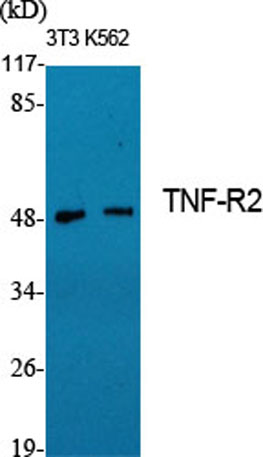
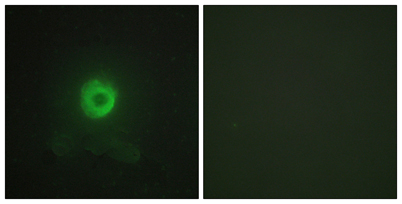
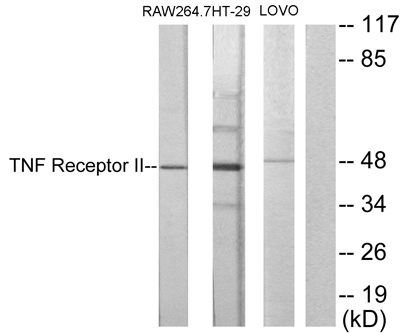
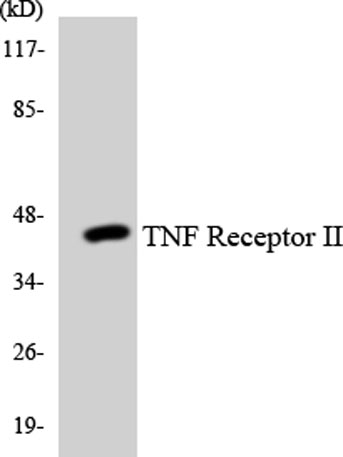
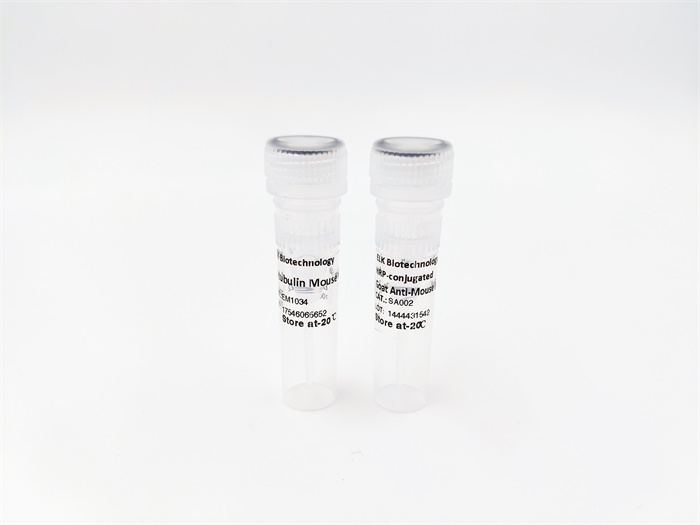



TNF-R2 rabbit pAb
 One-click to copy product information
One-click to copy product information$148.00/50µL $248.00/100µL
| 50 µL | $148.00 |
| 100 µL | $248.00 |
Overview
| Product name: | TNF-R2 rabbit pAb |
| Reactivity: | Human;Mouse;Rat |
| Alternative Names: | TNFRSF1B; TNFBR; TNFR2; Tumor necrosis factor receptor superfamily member 1B; Tumor necrosis factor receptor 2; TNF-R2; Tumor necrosis factor receptor type II; TNF-RII; TNFR-II; p75; p80 TNF-alpha receptor; CD antigen CD120b; Etanercept |
| Source: | Rabbit |
| Dilutions: | Western Blot: 1/500 - 1/2000. Immunohistochemistry: 1/100 - 1/300. Immunofluorescence: 1/200 - 1/1000. ELISA: 1/20000. Not yet tested in other applications. |
| Immunogen: | The antiserum was produced against synthesized peptide derived from human TNF Receptor II. AA range:376-425 |
| Storage: | -20°C/1 year |
| Clonality: | Polyclonal |
| Isotype: | IgG |
| Concentration: | 1 mg/ml |
| Observed Band: | 48kD |
| GeneID: | 7133 |
| Human Swiss-Prot No: | P20333 |
| Cellular localization: | [Isoform 1]: Cell membrane; Single-pass type I membrane protein.; [Isoform 2]: Secreted.; [Tumor necrosis factor-binding protein 2]: Secreted. |
| Background: | The protein encoded by this gene is a member of the TNF-receptor superfamily. This protein and TNF-receptor 1 form a heterocomplex that mediates the recruitment of two anti-apoptotic proteins, c-IAP1 and c-IAP2, which possess E3 ubiquitin ligase activity. The function of IAPs in TNF-receptor signalling is unknown, however, c-IAP1 is thought to potentiate TNF-induced apoptosis by the ubiquitination and degradation of TNF-receptor-associated factor 2, which mediates anti-apoptotic signals. Knockout studies in mice also suggest a role of this protein in protecting neurons from apoptosis by stimulating antioxidative pathways. [provided by RefSeq, Jul 2008], |
-
 Western Blot analysis of various cells using TNF-R2 Polyclonal Antibody diluted at 1:1000. Secondary antibody(catalog#:RS0002) was diluted at 1:20000
Western Blot analysis of various cells using TNF-R2 Polyclonal Antibody diluted at 1:1000. Secondary antibody(catalog#:RS0002) was diluted at 1:20000 -
 Immunofluorescence analysis of HeLa cells, using TNF Receptor II Antibody. The picture on the right is blocked with the synthesized peptide.
Immunofluorescence analysis of HeLa cells, using TNF Receptor II Antibody. The picture on the right is blocked with the synthesized peptide. -
 Western blot analysis of lysates from RAW264.7, HT-29, and LOVO cells, using TNF Receptor II Antibody. The lane on the right is blocked with the synthesized peptide.
Western blot analysis of lysates from RAW264.7, HT-29, and LOVO cells, using TNF Receptor II Antibody. The lane on the right is blocked with the synthesized peptide. -
 Western blot analysis of the lysates from HUVECcells using TNF Receptor II antibody.
Western blot analysis of the lysates from HUVECcells using TNF Receptor II antibody.

 Manual
Manual